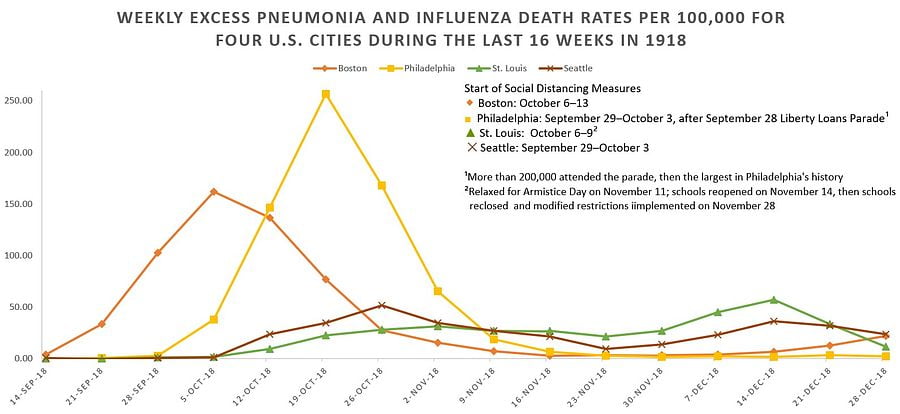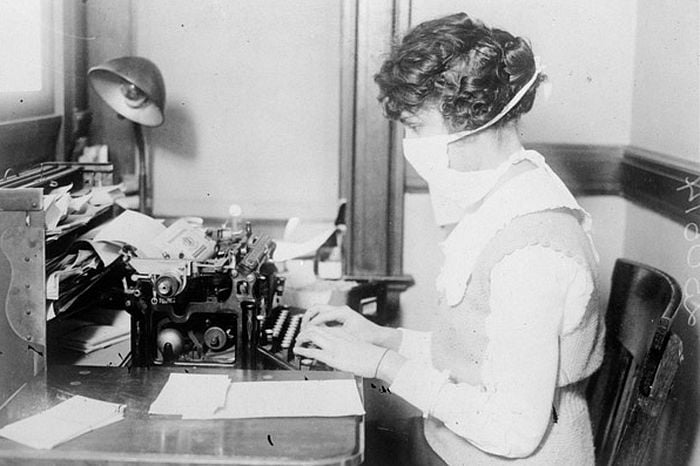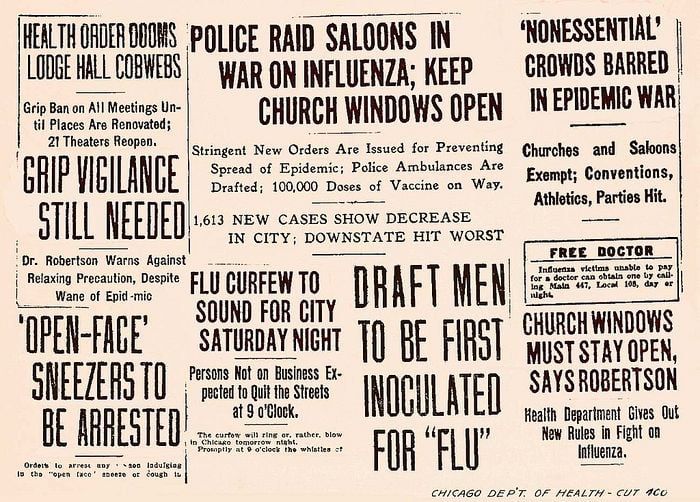The Spanish flu was the deadliest pandemic the world has seen. The medical community tried everything to fight the flu, from drugs and treatments to social measures.
Here are the treatments and measures that worked. Plus, how the Spanish flu finally came to a halt after unleashing chaos for a year.
The medical situation

The Spanish flu hit the world in 1918 when there was not much that the doctors could do to help their patients.
Back then, there were no antiviral drugs to fight viruses. And once the bacterial pneumonia set in, there were no antibiotics to combat the infection, nor were there any ventilators to help the patient breathe.
So the doctors were a bit constrained, but they tried every available treatment under the sun. Their treatments included oxygen therapy, hot baths, cold baths, morphine, quinine, drug cocktails -including an experiment with aspiring that went wrong-, and bloodletting.
And several vaccines were developed. But since the scientists had not isolated the virus that caused the flu, they were not effective.
What worked against the Spanish flu
Plasma transfusions

Among the medical treatments, the only one that had some effect was the plasma transfusion.
When a virus infects a person, their body fights off the intruder by creating specific antibodies against that virus.
After the virus is beaten, the antibodies remain in the blood. In that way, if the body gets reinfected, the antibodies are ready to fight the intruder again.
But the body takes a while to react to an unknown virus; it does not make the antibodies immediately. It may take a week, two, or more. And in that time, the virus may have already wreaked havoc in the body.
Enter the plasma transfusions. Someone who had recovered from the Spanish flu donated their antibody-rich blood. Their plasma was injected into someone that was sick with the flu. And the ready-made antibodies helped them fight off the virus.
It did not work in all cases, but the treatment did have moderate success. Furthermore, it was the only medical treatment that worked at all against the Spanish flu.
This same treatment is being used nowadays to fight Covid-19.
Social distancing and lockdowns

Social distancing rules and lockdowns were the best tools against the pandemic.
The towns that shut themselves up and prohibited or quarantined incoming visitors, banned gatherings, and closed schools and the like, were the ones that weathered the storm with few casualties.
Or in the case of Gunnison, Colorado, with zero casualties. That is quite impressive since all the towns surrounding Gunnison reported flu-deaths.
Shishmaref, Alaska, and American Samoa also went for a total lockdown and escaped the plague. They did not have one single sick person.
For comparison, other villages in Alaska that did not go into a lockdown lost up to 90% of their population. And unlocked Western Samoa, American Samoa’s neighbor, lost 22% of its population.
In the U.S., each town and city chose how to fight -or not fight- the flu.
San Francisco acted swiftly. Before the second wave of the flu arrived, the authorities quarantined visitors and closed schools, theaters, and bars. When the plague hit them, they had social distancing rules in place, and the use of masks was mandatory in public.
San Francisco had relatively few deaths during that second wave (1,800 in a population of 500,000).
But then the flu subsided, and the third wave hit them.
This time local business owners refused to comply with the mayor and close their stores, thinking that the masks – and not the lockdown- had saved them the first time. Sadly, they were wrong.
In the first days of January 1919, an average of 20 San Franciscans were dying with the flu every day.
And the mild third wave that elsewhere killed few, in San Francisco killed twice as many as the locked-down second wave.
Read more: How Many Died From the Spanish Flu? By Continent and Country
How did the Spanish flu stop?

After a year, the lethal flu had run its course. And it simply faded during the 1919 spring.
One of the possibilities is that the virus mutated into a milder strain.
Also, estimates suggest that 1/3 -or maybe even half- of the world population had caught the bug by 1919. And scientists believe that the survivors probably became immune to the virus.
One of the main reasons that this virus was so successful in the first place was because no one was immune to it in 1918, so it could easily jump from host to host.
But when 1/3 or 1/2 of its possible victims became immune, it ran into a wall. When it tried to jump to a new host, it was rebuffed. The virus did not have enough people to infect anymore, so the pandemic stopped.
Some scientists believe that there may have been one or two other waves after the 1919 spring. But so few were infected that most people do not count them as part of the pandemic.
So what really helped keep the number of dead down were the lockdowns and the social distancing measures. Once infected, the only medical hope for the person was a plasma transfusion, which sometimes worked, sometimes did not.
And the Spanish flu finally came to a halt when 1/3 or 1/2 of the world became naturally immune to the virus, the famous herd immunity.
Read next:
The Real Origin of the 1918 Flu Pandemic
The Key to the Spread of the Spanish Flu: the War
What Worked Against the Spanish Flu, and What Finally Stopped It
6 Traits That Made the Spanish Flu Unique
More Articles









